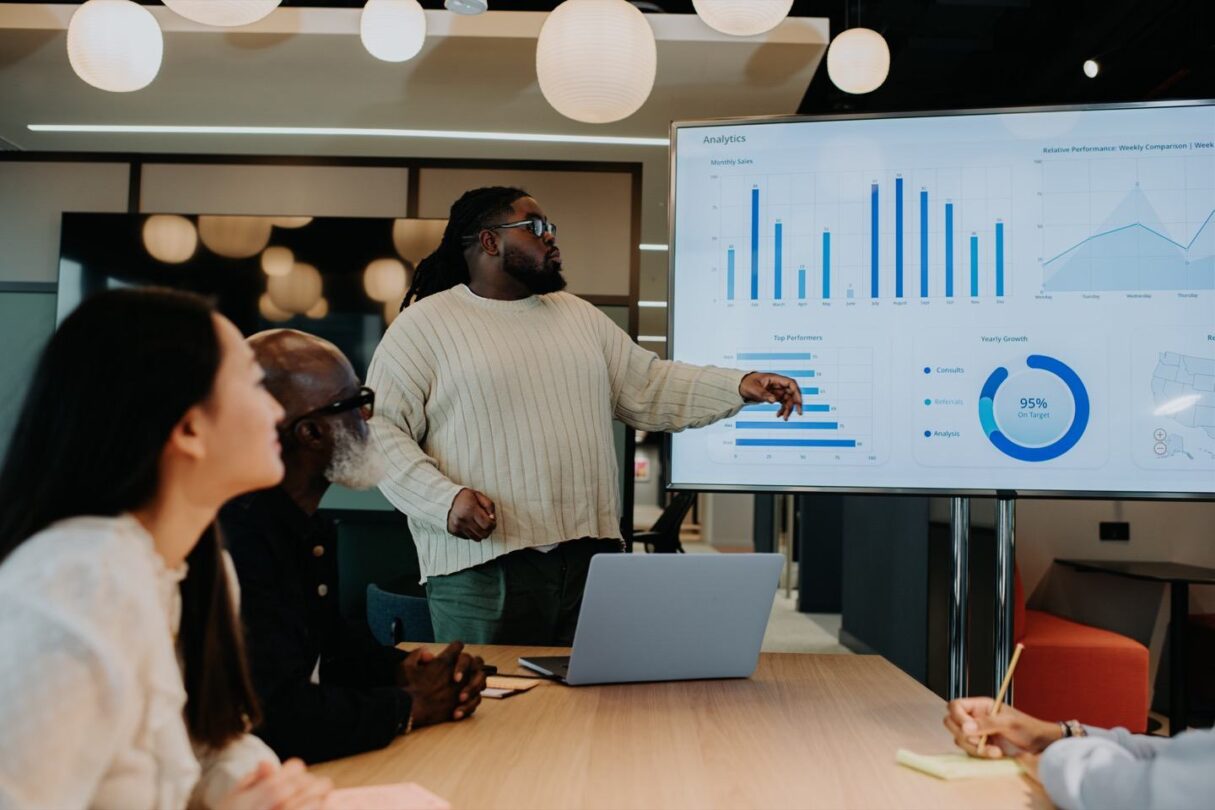Revolutionary reporting: Use data visualisation to boost business growth
Learn how data visualisation can lead to increased profitability, and why real-time data can result in making informed business decisions.

Stared at a spreadsheet so long that the numbers began to blur?
Or spent hours crunching data, only to struggle to explain the results to your team?
You’re not alone.
Today, where data is touted as the new gold rush, you might feel you’re drowning in a sea of data, but starving for insights.
What if there was a way to turn those raw, complex numbers into easily understandable, actionable insights?
This is where the power of data visualisation steps in.
In this article, we explore how this approach can revolutionise your financial reporting and fuel growth in your business, helping your finance team understand and better communicate your financial data to stakeholders.
Let’s dive in.
Here’s what we cover:
- Get insight to make good business decisions quickly
- What is visual reporting?
- The struggle with traditional reporting
- A lack of real-time data
- The power of customisable dashboards
- Data visualisation leads to increased profitability
- Enhanced communication and experimentation
- Final thoughts on data visualisation
Get insight to make good business decisions quickly
Analysing financial data quickly and accurately is becoming increasingly critical to stay competitive in your market.
As you digitalise your financial processes, you collect enormous amounts of data about operations and customers.
And what should you do with that data?
Use it to provide insights that your people can use to make better decisions.
One rising trend in financial reporting is visual reporting.
What is visual reporting?
Visual reporting provides a more intuitive way of understanding financial data, making it easier for stakeholders to identify key trends and insights.
It presents financial data in a more engaging and accessible format.
With the help of visual reporting, your finance team can create interactive dashboards and reports that provide real-time insights into your company’s financial health to inform strategic decision-making.
Visual reporting is gaining momentum.
Foundry is an integrated marketing technology and data provider firm. Its 2021 Data and Analytics survey found that 69% of organisations are piloting or using visual dashboards and data visualisation tools to consolidate and share information.
By 2025, data stories will be the most widespread way for organisations to consume analytics, according to research and consulting firm Gartner.
“Portraying financial data in a user-friendly way allows people to discover connections they wouldn’t have seen otherwise,” says Scott Freedman, director of marketing at Sage Intacct.
“With that information, they can make decisions that improve the business.”
But it’s yet to gain traction at many organisations.
Gartner says more than half of finance departments struggle to provide data or reports stakeholders can rely on to inform their decisions.
The struggle with traditional reporting
Despite the critical role that financial reporting plays in decision-making, traditional reporting methods can be challenging to manage.
The prevalence of data silos, which occur when data is stored in separate systems, makes it difficult to consolidate and analyse. This results in a lack of context and a fragmented view of the company’s financial health.
Another significant limitation of traditional financial reporting is the use of spreadsheets, which can be time-consuming and error prone.
Spreadsheets can be challenging to manage when dealing with large volumes of data. This can lead to inaccuracies and delays in decision-making, which can have significant consequences for your business.
A lack of real-time data
Today, you want to quickly access the most up-to-date financial data to make informed decisions.
Spreadsheets can’t handle real-time data, which can result in missed opportunities and costly mistakes.
Data is only useful when people can easily find it, understand it and put it to work. When data is buried in spreadsheets and scattered across departments, teams often don’t know where to look for it.
Searching takes time, and the numbers teams do find often lack context.
“Data is too often siloed and represented in ways that don’t allow people to slice and dice it the way they need to,” says Freedman.
In addition, spreadsheets can’t keep up with real-time operations.
“They are stuck in time,” adds Freedman. “They show recent or long-term past performance, but not the real-time reporting you need to predict the future.”
The power of customisable dashboards
Customisable dashboards are a powerful tool that can help your business consolidate and present financial data in a user-friendly way.
Frustrated by the inability to use their data effectively, management teams are turning to new solutions that collect data across the business and present it in customised dashboards.
The dashboards don’t just display facts and figures.
Instead, they create a narrative that places the data in context, along with graphical depictions that help bring it to life.
Your finance team can easily filter the information to learn what’s working and what’s not and then use these insights to improve operations or find new revenue opportunities.
Customisable dashboards play a crucial role in modern financial reporting by consolidating and presenting data in a user-friendly way.
Dashboards provide a real-time snapshot of critical financial data, allowing you to monitor key performance indicators (KPIs) and gain insights into your company’s financial health.
With dashboards, you can select the most relevant data points and visualise them in a way that is easy to understand and more accessible to a broader audience.
- Data narratives and graphical representations help to create a story around the data, providing context and insight into the numbers.
- Graphical representations, such as charts and graphs, help to visualise the data, making it easier to identify trends and patterns.
Customisable dashboards also help you tailor your reporting to specific user groups.
For example, executive-level dashboards may focus on high-level financial data, while departmental dashboards may drill down into more granular data relevant to specific teams. Each user group has the information they need to make informed decisions.
Data visualisation leads to increased profitability
An example of a company using data visualisation is Quicksilver Express Courier.
This ‘last mile’ delivery service collected data about its fleet but lacked visibility about individual vehicle profitability.
After adopting cloud financial software, Quicksilver’s finance executives could drill down into the profit and loss for each truck.
As a result, the company learned it was overpaying for workers’ compensation insurance, and subsequent adjustments saved £100,000 a year.
Other changes based on insights Quicksilver gained from the platform helped the company increase total profitability at some locations by 5% to 25%.
Enhanced communication and experimentation
Customisable dashboards provide a snapshot of critical financial data and can improve communication between your executives and teams.
Your senior executives can confidently make informed decisions with real-time access to the most up-to-date financial data.
Additionally, customisable dashboards facilitate communication between executives, finance teams, and organisational units.
Dashboards provide a common language that everyone in your business can understand, helping to break down silos and ensure everyone is on the same page.
This not only improves communication but also helps to build a culture of data-driven decision-making.
Access to the same data allows your people to collaborate more effectively, leading to better outcomes.
Experiment and innovate with real-time visualisation
Customisable dashboards provide a powerful tool to experiment, innovate, and make data-driven decisions-based insights you gain from real-time data visualisations.
Think about playing around with your dashboards, using real-time information, charts, and graphs. It’s about trying out ideas for improving processes or services.
“You can look backwards or forward and use real-time insights to predict future results,” says Freedman.
With access to real-time data, you can test ideas and adjust on the fly, helping your teams respond quickly to changing market conditions.
For example, your marketing teams can use real-time data to test different messaging and campaigns, while product teams can use data to identify areas for improvement and drive innovation.
The ability to experiment and innovate in real-time is a significant advantage. You can stay ahead of the competition and drive growth with real-time data visualisations.
Final thoughts on data visualisation
Data visualisation and customisable dashboards provide the business tools to analyse financial data quickly and accurately, ensuring you stay ahead of the curve and make better-informed decisions.
Visual reporting provides a more intuitive way of understanding financial data, making it easier for your stakeholders to identify key trends and insights. Consolidate and present financial data in a user-friendly way, and you’ll improve communication between executives and teams,
Don’t wait any longer to unlock the full potential of your financial data and fuel growth in your organisation.
Consider exploring the power of data visualisation tools to transform your reporting process today, which may mean looking at financial management software tailored to your needs.







Ask the author a question or share your advice